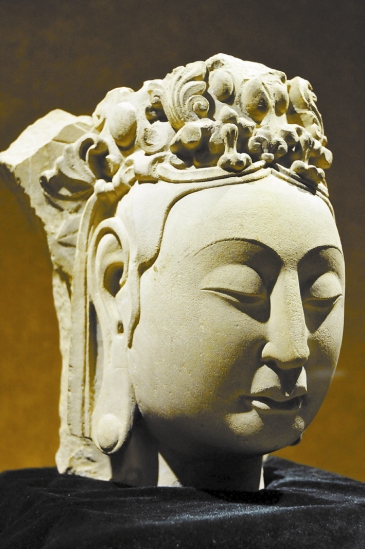|

Newman Huo
TO so many people, Shanxi Province is simply known for its coal mining industry. But Li Yong, vice president of the Shanxi Museum, believes the province has something more important than its coal mining, which is its “long history and rich culture.”
“The ancient Buddhist sculptures scattered throughout Shanxi Province, including those of the world-famous Yungang Grottoes and Tianlongshan Grottoes, are a showcase of the province’s long history and rich culture,” said Li.
The “Solemn Images of Buddhist Sculptures from Shanxi Province” exhibition at the Shenzhen Museum is giving people a best chance to know the province’s history and culture.
The exhibition, scheduled to run until Aug. 28, features 61 sculptures, of which 23 pieces are national first-class cultural relics.
“This doesn’t mean that the other sculptures are less important. Instead, many other pieces were unearthed as recently as the 1990s or were recently transferred to the Shanxi Museum, so many of them have never been shown to the public,” Li said.
The exhibition is divided into two parts: “The Look of the Northern Dynasties” and “The Spirit of the Sui and Tang Dynasties.”
Highlights include the standing stone statute of Bodhisattva of the Eastern Wei Dynasty (534-550) unearthed at the Xiangfu Temple in Yushe County in 2001, the gilt bronze statute of Vajrapanibalin of the Northern Qi Dynasty (550-577) unearthed in Shouyang County in 1986, and the seated statute of Sakya of the Tang Dynasty unearthed at Fenglingdu in Ruicheng County in 1982.
Buddhism is one of the most important religions in China. It is generally believed that it was introduced from India in 67 during the Han Dynasty (206-220 B.C.).
Buddhist art originated on the Indian subcontinent following the historical life of Siddhartha Gautama in the 6th to 5th century B.C., and evolved by contact with other cultures as it spread throughout Asia and the world.
Buddhist art followed believers as Buddhism spread, adapted and evolved in each new host country.
Buddhism brought with it a new type of art into China, particularly in the field of statuary. Receiving this distant religion, strong Chinese traits were incorporated into Buddhist art.
In the 5th to 6th centuries, the Northern Dynasties developed rather symbolic and abstract modes of representation, with schematic lines.
Their style is also said to be solemn and majestic. The lack of corporeality of this art, and its distance from the original Buddhist objective of expressing the pure ideal of enlightenment in an accessible and realistic manner, progressively led to a change towards more naturalism and realism in the Buddhist art of the Tang Dynasty (618-907).
Following a transition under the Sui Dynasty (581-618), Buddhist sculpture of the Tang Dynasty evolved towards a markedly life-like expression as Buddhism reached its zenith in China.
Because of the dynasty’s openness to foreign influences, and renewed exchanges with Indian culture due to the numerous travels of Chinese Buddhist monks to India, Buddhist sculpture in the Tang Dynasty assumed a classical form, inspired by the Indian art of the Gupta period.
During that time, the Tang capital city of Chang’an, today’s Xi’an in Shaanxi Province, became an important center for Buddhism.
In the Buddhist sculptures of the Sui and Tang dynasties, the simplification of the Han Dynasty was no longer seen.
Instead, foreign elements were boldly absorbed into the localization of Buddhist art, giving it the style and feature of the time, such as plumpness, fitness and elegance. This makes up the most glorious chapter in the history of Buddhist art in China.
The exhibition is organized jointly by the Shanxi Museum and the Shenzhen Museum. All exhibits are selected from collections of the Shanxi Museum.
Dates: Through Aug. 18
Hours: 9 a.m.-5 p.m. Closed Monday
Add: Shenzhen Museum, 1008 Shennan Road Central, Futian District (福田区深南中路1008号深圳博物馆)
Buses: 2, 3, 8, 12, 101, 103, 104, 113, 203, 204, K113, K204, 215, 223, 311
Metro: Da Ju Yuan Station (Grand Theater Station 大剧院站), Exit B
|

